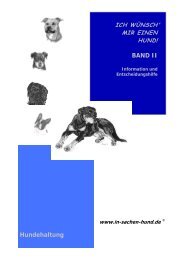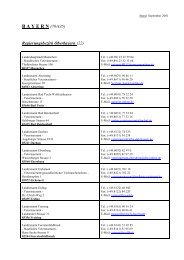Zum PDF-Dokument - 780 KB - In-sachen-hund.de
Zum PDF-Dokument - 780 KB - In-sachen-hund.de
Zum PDF-Dokument - 780 KB - In-sachen-hund.de
Sie wollen auch ein ePaper? Erhöhen Sie die Reichweite Ihrer Titel.
YUMPU macht aus Druck-PDFs automatisch weboptimierte ePaper, die Google liebt.
Summary 121<br />
G. Summary<br />
Analysis of biting inci<strong>de</strong>nts in Berlin based on their reflection in daily newspapers<br />
Subject of the study is the coverage of dog attacks and dog bites in five Berlin daily newspapers.<br />
Focus of the analysis are the characteristics of the topic’s presentation with particular consi<strong>de</strong>ration of<br />
principal differences between broadsheets and tabloids. It is further attempted to highlight the print<br />
media’s potential for manipulating public opinion.<br />
Tabloids generally try to attract the curiosity and attention of rea<strong>de</strong>rs by using eye-catching pictures<br />
and short and simple headlines in oversized fonts. The larger the headlines’ letters the more<br />
emotionally charged they often are. Both broadsheets and tabloids are found to at times use wrong<br />
captions and to i<strong>de</strong>ntify different dog races in one and the same picture. The pictures used further<br />
repeatedly <strong>de</strong>pict extremely intimidating dogs whose exaggerated dangerousness does not match the<br />
contents of the accompanying article. <strong>In</strong> some cases the pictures and the synonym “Kampf<strong>hund</strong>” have<br />
no association to the subsequent article at all.<br />
When compared with the total number of articles, the tabloids as well as the Berliner Morgenpost<br />
publish the most front page teasers. Especially in case of the tabloids, the articles accompanying such<br />
teasers rarely appear on the same page and on average are placed badly or inconspicuously.<br />
The length of their respective articles constitutes a major difference between broadsheets and<br />
tabloids. Characteristic for the style of the tabloids are short, simply written articles adapted to the<br />
target audience. Longer and more informative articles are primarily found in the broadsheets. When<br />
compared to broadsheet articles, tabloid articles are far more commonly artificially enlarged by the<br />
use of pictures and oversized headlines.<br />
Tabloids predominantly publish short reports, accounts and reportages and present the opinion of<br />
their rea<strong>de</strong>rs in form of letters to the editor. Broadsheets additionally contain comments, glosses,<br />
editorials, portraits, analysis and documentaries. The variations in the form of presentation are more<br />
complex, one could say more sophisticated. <strong>In</strong> addition to the rea<strong>de</strong>rs’ opinion, broadsheets purposely<br />
inclu<strong>de</strong> the views of both the responsible journalists and the newspaper.<br />
<strong>In</strong> the broadsheets and the Berliner Kurier, articles covering dog attacks or dog bites are mostly<br />
published in sober form as a report or analysis. The more exiting articles in the form of reportages,<br />
reports in the style of reportages or features are predominantly found in the tabloids.<br />
While potential means for and elements of manipulation of the rea<strong>de</strong>rs are predominantly found in the<br />
tabloids, the broadsheets are not free of these either. By using simple language and repeating certain<br />
terms and pictures newspapers prompt their rea<strong>de</strong>rs to memorise matters. The confirmation of<br />
prejudices by a newspaper reinforces the rea<strong>de</strong>r’s views and allows him to bond with the newspaper<br />
in question. Especially the tabloids try to conform with their rea<strong>de</strong>rs’ opinions and views and to write<br />
what their target audience wishes to read.<br />
The results of the study show that there are characteristic differences in the coverage by tabloids and<br />
broadsheets and that newspapers target a particular audience with their form of reporting. However,<br />
it also becomes apparent that the writing of an article does not always follows a stringent formula but<br />
that the final result always <strong>de</strong>pends on the general situation with regard to breaking news at the time<br />
as well as which hands the relevant news passes through on its way to publication.




